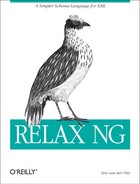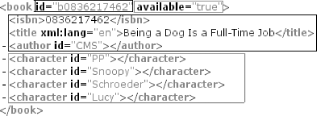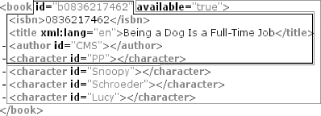A Simple Example
Let’s take a look
at an example. Figure 2-1 shows the
book element with its two attributes and four
different subelements:
With a DTD and, to a lesser extent, with W3C XML Schema, you are stuck defining lists of attributes and elements you can’t mix or combine. W3C XML Schema has introduced the concept of types, abstract descriptions that have no direct corollary in the contents of XML documents. Types provide descriptions of the contents of elements or attributes, but types still can’t be freely combined together. This means that you can split the description of elements into blocks such as those shown in Figure 2-2, but can mix the blocks in a limited number of ways.
RELAX
NG patterns, however, can freely mix different types of nodes
(elements, text and attributes). Figure 2-3 shows
how, if you want to, you can use RELAX NG to split the definition of
the book element into a first pattern composed of
the attributes id, title, and
author and the element
character, and then a second pattern composed of
the available attribute and the other
character elements.
The flexibility just demonstrated isn’t only useful for combining complex patterns. It also maintains the simplicity desired by RELAX NG schema designers who don’t need or want to learn a long list of design limitations that must be checked when they write and combine their schemas.
This generic concept of patterns is powerful enough to replace the specialized containers of DTDs and W3C XML Schema. RELAX NG has no need for (and no notion of ) specially reusable components. Elements, attributes, and types are all embedded in patterns. These patterns are the reusable building blocks of RELAX NG. They can be named, reused, and even redefined at will, combined through operators to group them or to provide alternatives among them.
The benefit of having nonspecialized patterns is increased flexibility. These benefits are similar to those seen in manufacturing: repeatedly using a small number of generic parts to create a unique whole provides more flexibility and a higher number of possible combinations than using more specialized pieces. This works for XML schema languages, too.



